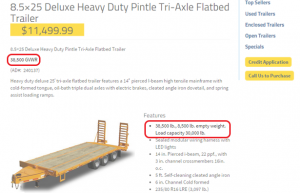Understanding Trailer Weight Ratings: GVWR, GAWR, and More – A Pro-Line® Trailers Guide
When it comes to towing a trailer, understanding weight ratings is crucial for both safety and legality. Terms like GVWR and GAWR often appear in trailer specifications, but what do they mean? In this comprehensive guide by Pro-Line® Trailers, we’ll break down these terms and explain their importance in safe and legal towing.
1. What is GVWR?
GVWR stands for Gross Vehicle Weight Rating. It is the maximum weight that a trailer can safely carry, including its own weight.
2. Understanding GAWR:
GAWR, or Gross Axle Weight Rating, is the maximum weight that can be placed on a single axle of the trailer.
3. Importance of Tongue Weight:
Tongue weight is the amount of weight that the trailer tongue places on the hitch. It should be about 10-15% of the total trailer weight for balanced towing.
4. Payload Capacity:
This is the weight of the cargo that the trailer can carry. It is calculated by subtracting the trailer’s empty weight from its GVWR.
5. How to Measure Trailer Weight:
Using a certified scale is the most accurate way to measure your trailer’s weight. Always include the weight of any cargo and fluids.
6. Legal Implications:
Exceeding weight ratings can result in fines and may void your trailer’s warranty. Always adhere to the specified GVWR and GAWR.
7. Safety Concerns:
Overloading a trailer can lead to poor handling, increased stopping distances, and even catastrophic failure of the trailer or towing vehicle.
8. Manufacturer Guidelines:
Always refer to the manufacturer’s guidelines for accurate weight ratings. Pro-Line® Trailers provides detailed specifications for all our models.
Conclusion:
Understanding trailer weight ratings is essential for safe and legal towing. By familiarizing yourself with terms like GVWR and GAWR, you can ensure that you are using your trailer within its designed limits. For more information on trailer specifications and safe towing practices, visit Pro-Line® Trailers or call us at 540-334-4182.





